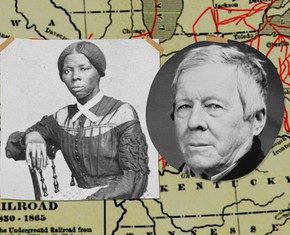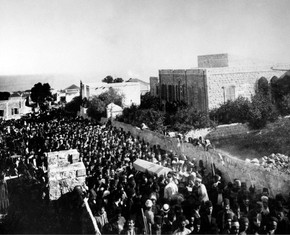The views expressed in our content reflect individual perspectives and do not represent the authoritative views of the Baha'i Faith.
Previously, in an earlier essay in this series, you met Robert Turner, the first African American Baha’i (1898), and read about Abdu’l-Baha’s tablet in honor of Mr. Turner. That particular tablet introduced Baha’u’llah’s “pupil of the eye” metaphor as applied to people of African descent.
This beautiful, metaphorical image acted as a powerful antidote to the negative racial stereotypes that prevailed in Jim Crow America at the time. Of course, Abdu’l-Baha already knew about America’s Jim Crow apartheid. But he saw first-hand the evidence of forced segregation and racial hatred when he visited America in 1912, a decade after his letter to Robert Turner.
Baha’u’llah’s “pupil of the eye” metaphor appears in other letters and tablets, too:
As to Robert, Alice and Louise: Verily, the faces of these are as the pupil of the eye. Although the pupil is created black, yet it is the source of light. I hope God will make these black ones the glory of the white ones, and as a depository of the lights of the Love of God. And I beg of God to assist them in all circumstances, that they may be encompassed with the Favors of their Loving Lord throughout centuries and ages. – Abdu’l-Baha, Tablet to Sarah Farmer, translated by Ali-Kuli Khan, September 13, 1902.

Robert Turner
It’s probably safe to say that this “Robert” is none other than the distinguished Robert Turner. As for “Alice” and “Louise,” it’s obvious from the text that these were two African American women who apparently were drawn to the Baha’i teachings, and most likely embraced the Baha’i Faith, even though no formal records verify this likely fact.
Observe here the clear association of the “pupil of the eye” as the “source of light” with the “lights of the Love of God.” Although a narrow reading of this metaphor might otherwise limit its interpretation to light that travels into the pupil of the eye and onto the retina, a broader reading of this “pupil of the eye” metaphor has another meaning—it recognizes what African-Americans (and people of African descent generally) have witnessed and experienced historically, collectively endowing them with a heightened sensitivity to suffering and oppression and deepening their capacity for empathy, social justice, and interracial harmony.
Here is another “pupil of the eye” tablet:
To Alma S. Knobloch.
Blessed are you that to you the White and the Black are one. Whiteness is by the light of the heart and not the skin; and Blackness is the blackness of the heart and not the face. The reflection of a person is seen in the black pupil of the eye. How many there are who have black faces but their characters are white and illumined. I am most happy on account of this work which you have been doing; it is the cause of the whiteness and the illumination of your spirit. Abdu’l-Baha Abbas
Today, it may not be “politically correct” to speak about “Whiteness” and “Blackness” in this way. But this text must be read and appreciated squarely within the immediate social context of that day and age. Here, “Whiteness” is shorthand for “light” and, more importantly, for “enlightenment.” Sunlight, more or less, is often described as a “white” light. This color is independent of race. “Blackness,” by contrast, is simply the absence of light. It is also independent of race. Here, “light” simply serves as a physical metaphor for spiritual enlightenment.
Note also this statement by Abdu’l-Baha: “The reflection of a person is seen in the black pupil of the eye.” In other words, the “pupil of the eye” is a mirror of social reality.
On May 21, 1921, the first day of the “Convention for Amity Between the Colored and White Races Based on Heavenly Teachings” (the original idea for which came from Abdu’l-Baha) was held. Referring back to this historic event, Abdu’l-Baha, in a Tablet to Roy Williams (an African-American Baha’i from New York City), wrote:
I hope that the Congress of the White and the Colored that was instituted will have great influence in the inhabitants of America, so that everyone may confess and bring witness that the teachings of His Holiness, Baha’u’llah, assembles the White, the Black, the Yellow, the Red and the Brown under the shade of the pavilion of the Oneness of the World of Humanity; and that if the teachings of His Holiness, Baha’u’llah, be not enforced, the antagonism between the Colored and the White, in America, will give rise to great calamities. The ointment for this wound and the remedy for this disease is only the Holy Breaths [Holy Spirit]. If the hearts be attracted to the Heavenly Bounties, surely will the White and the Colored, in a short time, according to the teachings of Baha’u’llah, put away hatred and animosity and [abide in] perfect love and fellowship. — Abdu’l-Baha, Haifa, August 2, 1921, translated by Touhi [Ruhi] M. Afnan.
Abdu’l-Baha says we can find the “ointment for this wound and the remedy for this disease” in spiritually inspired thought and practice. Nothing short of a truly spiritual reorientation can succeed in healing racism, and transforming prejudice into friendship and appreciation.
Race relations has a long and checkered history. Here, the Baha’i influence is profoundly positive—not only historically, but in present-day social transformation and progress as well.
Thank you to the U.S. National Baha’i Archives and Lewis V. Walker, Associate Archivist, for the provision of these historical documents.
















Comments
Sign in or create an account
Continue with Googleor